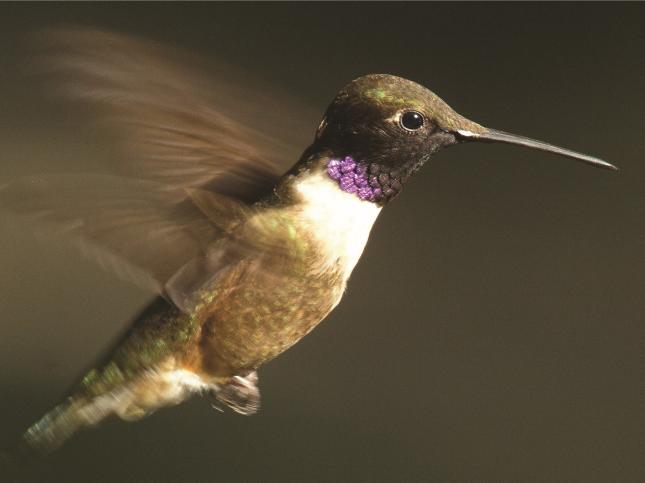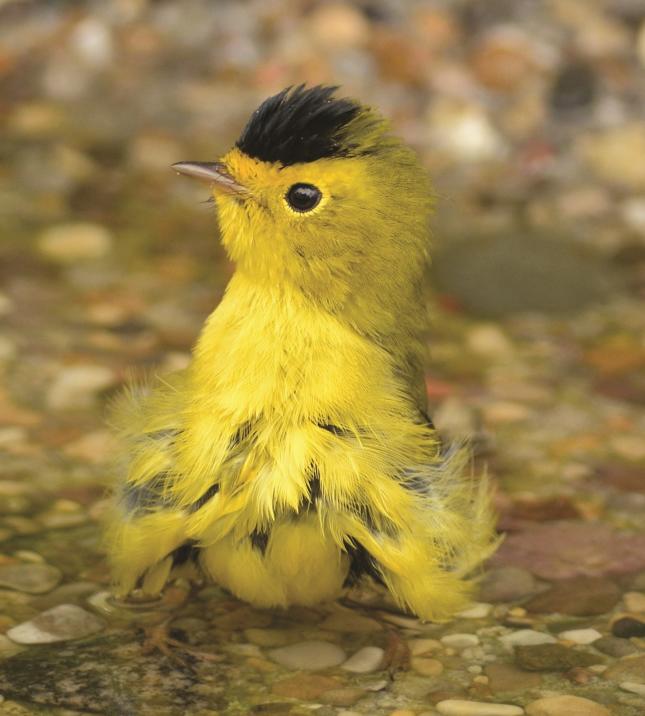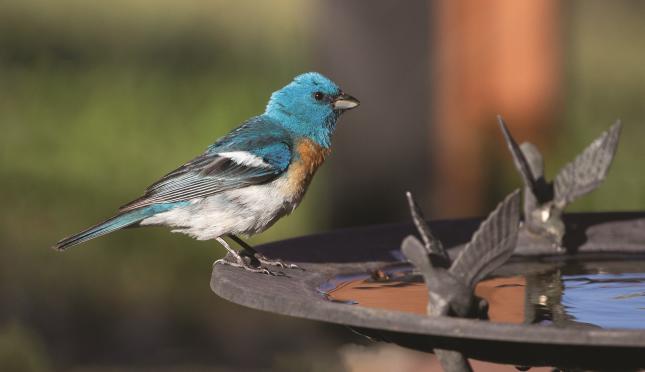September Nature: Colorful Migrants
 September is the last month to see Black-Chinned Hummingbirds. They head south at the end of the month for warmer locations in western and southern Mexico. But don't take down your feeders yet. The Black-Chinneds need to pack on calories for the long trip, while our other hummers, such as the familiar Anna's and Allen's, are here and active throughout the winter. Keep your feeders full of nectar, and hummingbirds will brighten those cool gray winter days.
September is the last month to see Black-Chinned Hummingbirds. They head south at the end of the month for warmer locations in western and southern Mexico. But don't take down your feeders yet. The Black-Chinneds need to pack on calories for the long trip, while our other hummers, such as the familiar Anna's and Allen's, are here and active throughout the winter. Keep your feeders full of nectar, and hummingbirds will brighten those cool gray winter days.
Left: A Black-Chinned Hummer hovers to get more nectar
As the summer regulars—Orioles, Grosbeaks, Tanagers and Buntings--leave for the winter, don't stop watching your feeders. This month you may spot the first White-Crowned Sparrows arriving for the cool season. These little ground feeders with the distinctive black-and-white stripes on their heads, will hop under your bushes all winter, foraging for seeds.

The White-Crowned Sparrows arrive amid hordes of Warblers passing through on their way south, with a few staying for the winter. Up to 45 different warbler species have been identified in SoCal, though many of them are rare migrants. One you are most likely to see flitting through your garden in September is the brilliant Yellow Warbler. Yellow also distinguishes another September regular, Wilson's Warbler. Its jaunty black cap bobs as it probes, jumps and hovers to glean bugs. Neither will stay, but they are a cheerful note as summer fades into fall.
Right: A migrating Wilson's Warbler enjoys a bath break
Small, greenish yellow and hidden deep in bushes, Orange-Crowned Warblers nevertheless are common visitors, especially in the fall, as they migrate into or through this area. Expert gleaners, they move through dense bushes, picking out tiny bugs. They more often are heard than seen, though their call is a simple trill. They will winter in SoCal gardens where they can find bugs year-round. They also like blooming eucalyptus trees for the abundant nectar.

Left: A Lazuli Bunting also finds a birdbath inviting
The arrival of a Lazuli Bunting at your birdbath can feel like a mixed blessing. These efficient seed foragers have been termed “fire followers” by some, because they often appear after large burns of chaparral. Though not the brilliant overall blue of the Indigo Bunting, the handsome males still sport a bright blue head and back over a rust and white breast.
If you've recently spotted the glowing red and yellow of a Western Tanager, it's probably a migrant already on the move to Baja or western Mexico. They stop in to SoCal backyards for water and few bugs on their trip. Occasionally, one will stay around if it finds flowering eucalyptus, whose nectar is a favorite winter food.
 Right: Jack Black, Steve Martin and Owen Wilson try to win the Big Year
Right: Jack Black, Steve Martin and Owen Wilson try to win the Big Year
The comedy, The Big Year (Jack Black, Steve Martin, Owen Wilson), focused on a trio of birders competing to spot and identify the most species in one year (while also trying to resolve some personal issues). Few of us can devote a year to bird watching, but, if you have just one day, 24 hours, on Oct. 11, 2025, you can compete with three-quarters of a million people to tally species on the eBird Big Day. To join, sign up for a free eBird account and download the free mobile app. To get the most out of your Big Day, eBird has free courses on how to use the app, the best places near you to watch for birds and the Merlin app to identify birds. The Big Day is timed to coincide with Global Bird Weekend and World Migratory Bird Day. So get ready for Oct. 11; the birds are waiting.

